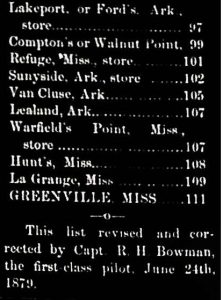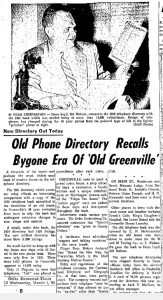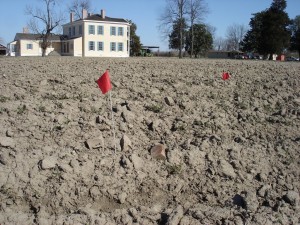19th December Calendar
This December calendar, found behind Lakeport’s North Parlor, lines up with dates in 2018. The calendar is most likely late 19th century. Possible years are 1906, 1900, 1894, 1883 or 1877.
This December calendar, found behind Lakeport’s North Parlor, lines up with dates in 2018. The calendar is most likely late 19th century. Possible years are 1906, 1900, 1894, 1883 or 1877.
Greenville, Mississippi has a solid run of city directories from 1913-present, with 1918-1926 as the most significant gap. Filled with names, businesses, addresses, and other information, directories are important resources for historians and genealogists. Directories are also a record of the town’s growth from a small county seat of under 1,000 people in 1865 to a city of over 40,000 in 1960.
The oldest directories that include Greenville are business directories along the Mississippi River. Having been rebuilt (and moved north) after the Civil War, Greenville was just a few years old in 1871, when the James’ River Guide wrote: “county seat of Washington co., Miss., is a small village. Population about 300.” While across the river, Chicot County’s more established seat, Columbia, seemed to be thriving: “IT is a very pleasant place, containing a number of stores, a court-house, and a population of about 400. Here commences the great cotton growing region, and the banks of the river are almost one succession of plantation. Just below this commences the growth of the Spanish moss.”
Two business directories centered around Vicksburg published in 1877 and 1879 also lists Greenville as a stop along the river just above “La Grange, Miss.”

Business Directory of Vicksburg, Jackson, Meridian, and Stations on the Vicksburg & Meridian R.R. (Abel C. Tuttle, Vicksburg, Miss, 1879). Microfilm in Mississippi Department of Archives & History, Jackson.
During the last decades of the 19th century, town grew in population and modern amenities. The telegraph arrived in Greenville in 1877 and railroads crossed the town in all cardinal directions by the 1880s. Electricity came in 1888 and two years later a network of two electric streetcars was unveiled. That year the city reached a population of 7,642.
In the Lakeport Plantation Collection is a Greenville telephone directory from 1900. The directory, published by the Cumberland Telephone & Telegraph Company, contains 347 listings. In 1906 the Cumberland Telephone & Telegraph Company claimed their “Long distance lines and telephone enable you to talk almost any where in Southern Indiana, Southern Illinois, Kentucky, Tennessee, Mississippi and Louisiana.”
In 1961, the Delta-Democrat Times (March 1, 1961) chronicled “Greenville’s 40 year evolution from town to city” by comparing a 1961 directory to a newly discovered 1920 directory. Unearthed in a demolition of an old house, the 1920 directory was in the possession of Dean Loyd of 838 Bolivar St in 1961; today its location isn’t known and no copy of a 1920 Greenville directory can be found in any archive. According to the DDT, the 1920 directory had 1,428 listings compared to more than 11,000 in the 1961 directory. In that 40 year period, Greenville’s population grew from 11,560 to 41,502.
If you have Greenville city directory or telephone directory not in any archive, tell us about it.

“Old Phone Directory Recalls Bygone Era of ‘Old Greenville’,” Delta Democrat-Times, March 1, 1961 (read the full article)
Where to access Greenville City Directories:
Ancestry.com has Greenville’s city directories (1913-1960) in its U.S. City Directories, 1822-1995 database. Ancestry requires a monthly fee to access its databases, but many local libraries and LDS Family History Centers offer access to patrons. Ancestry’s database is part of a microfilm collection offered by the Library of Congress & the Gale Group. Microfilm copies of the Greenville’s directories, 1913-1960 can be found in a number of libraries, including the William Alexander Percy Library in Greenville.
Ancestry.com ($): 1913, 1916, 1927, 1929, 1931, 1936, 1938, 1940, 1946, 1950, 1954, 1956, 1958, 1960
Delta State University/McCormick Collection: 1960-2001
Greenville History Museum:
Lakeport Plantation: 1900 telephone directory
Library of Congress: 1913-1917, 1927-1940, 1946-1960 [1913, 1916, 1927, 1929, 1931, 1936, 1938, 1940, 1946, 1950, 1954, 1956, 1958, 1960]
Memphis Public Library: 1918
Mississippi Department of Archives & History:
St. Louis County Library: 1913-14, 1916-17, 1927-32
University of Memphis: 1918, 1975
University of Mississippi: ca.1913, 1918, 1975
University of Southern Mississippi: 1946, 1950-51, 1954, 1956, 1958, 1960, 1961, 1962, 1964, 1965, 1966, 1968, 1969, 1971-79, 1987, 1989
Washington County Courthouse:
William Alexander Percy Library/Washington County: 1913-1932, 1936-1951 [microfilm]; 2010, 2011, 2012, 2014, 2015, 2016 [4 others with no date in catalog] [screenshot];
Works consulted:
Keating, Bern. A History of Washington County. Greenville, MS: The Greenville Junior Auxiliary, 1976.
Willis, John C. Forgotton Time: The Yazoo-Mississippi Delta after the Civil War. Charlottesville: University of Virginia Press, 2000.
 During the week of February 16 to 20, archeologists from the Arkansas Archeological Survey and the Lakeport Restoration Team members flocked to Lakeport to try to answer burning historical questions about the antebellum layout of the plantation. Skip Stewart-Abernathy, a survey archeologist stationed at the Winthrop Rockefeller Institute atop Mt. Petit Jean, led the project. Dr. Stewart-Abernathy, who first visited Lakeport in 1984, specializes in historic archeology.
During the week of February 16 to 20, archeologists from the Arkansas Archeological Survey and the Lakeport Restoration Team members flocked to Lakeport to try to answer burning historical questions about the antebellum layout of the plantation. Skip Stewart-Abernathy, a survey archeologist stationed at the Winthrop Rockefeller Institute atop Mt. Petit Jean, led the project. Dr. Stewart-Abernathy, who first visited Lakeport in 1984, specializes in historic archeology.
Lycurgus Johnson constructed Lakeport ca. 1859, just at the end of the antebellum period. Lycurgus built his house just north of Joel Johnson’s house—his father. Joel Johnson arrived at that location in 1831 with 23 slaves. By 1860, Lycurgus, after consolidating his father’s holdings with his own. had over 4,000 acres of land and 155 slaves.
On this archeological “dig,” no digging was necessary. All the land around the house is still in cultivation and had been recently plowed, giving high visibility. Crews walked the furrows looking for significant artifacts—bits of dishes, marbles, bottles, agricultural parts, etc.—all of which can be dated. Artifacts collected during the “dig” have been labeled, numbered and cataloged and will remain in the permanent collection at Lakeport Plantation. Most artifacts around the plantation dated to after the Civil War and usually represented the former tenant farmer homes that dotted the land after the Civil War until mechanization; however almost all of the antebellum artifacts, were found south of the Lakeport home around where Joel Johnson began building his plantation out of the wilderness in 1831. This leads us to believe that Lycugus kept the location of his father’s “quarters.”
This week of archeology is part of the on-going research at Lakeport Plantation and helps fulfill the mission of interpreting the people and cultures that shaped plantation life in the Mississippi River Delta during the Antebellum, Civil War, and Reconstruction periods. We’re open Monday thru Friday with tours at 10am and 2pm. Visit our website for directions.
